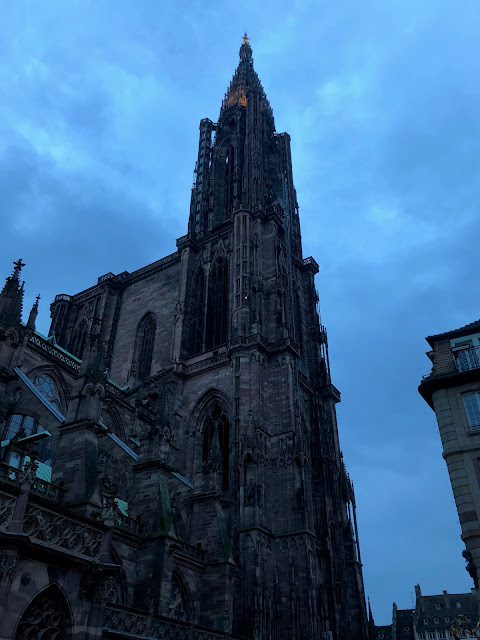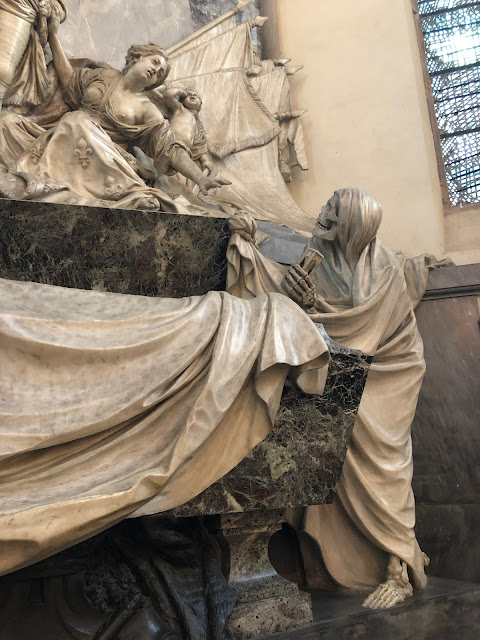We don't consciously seek out places that look like Castle Dracula. Well, actually we do. And compared to places like the Cathar castles in Queribus and Peyrpeteuse that we visited down south years ago, Strasbourg's cathedral really delivered.
 |
| Château de Quéribus, Cucugnan |
 |
| Château de Peyrepetuse, Rouffiac-des-Corbières |
But that was not why we took a side trip to Strasbourg, in the Grand-Est region (formerly Alsace), just across the Rhine River from Germany. We had hoped to visit the famous Christkindelsmärik (Christmas Market) last winter, but got organized too late to get an affordable hotel room. So we contented ourselves with a post-May Day trip, principally to enjoy the Alsatian architecture and cuisine.
Of which we got plenty of both. We stayed in a 16th century, half-timbered building that was the site of a continuously operating apothecary (later, pharmacy) from 1298 until 2000 (La Pharmacie du Cerf). The ground floor now houses an ice cream shop--which is probably a therapeutic upgrade compared to what was sold for the first few hundred years until laudanum and opium became widely available. The apartment had been updated, but the units themselves were cobbled together from at least four adjoining buildings, forming a warren of hallways around a carved, wooden circular stairwell and an atrium to bring light and fresh air into the interior apartments.
Much of the Old Town had the same classic half-timbered look, with tightly-packed buildings leaning on one another after a few too many rieslings and gewurtztraminers, and bulging outward over the sidewalks near the bottoms. As charming as these were, they were no match for the scale of the Cathédrale Notre-Dame-De-Strasbourg. Our entrance to the Phamacie du Cerf directly faced the cathedral. The first time we saw it, we rounded the corner of a narrow passage and were pretty much dumbstruck over the sight of it looming over the square. We weren't more than 50 meters away, but it still had a washed out looked like a distant mountain or a skyscraper seen from blocks away--which is fitting, considering that after its spire was added in 1439, it was the world's third- or second-tallest building until 1674--the year when it gained the top spot after fires burned the spires of Saint Mary's church in Germany (Beauvais cathedral's 153 meter spire burned in 1569). Saint Nikolai in Hamburg edged it out by 5 meters in 1874. The footprint of the cathedral is so large that it fills your entire field of of vision from anywhere in the square. Your eyes can't entirely take in a straight-on view of the church without swiveling your head--nor can your camera, as evidenced by the hundreds of tourists walking slowly backwards with their phones pointed skywards, their backs arched into question marks.
 |
The approach to la Place de la Cathédrale near the Maison Kammerzell.
|
 |
| As much of the façade as I could fit in the frame from 20 meters away, backed up against the wall of Pharmacie du Cerf. |
As much as Strasbourg's Old Town buildings were grand, gothic, or classic, we also noticed a few oddballs as we strolled and biked around the edge of its intersecting rivers and canals. An international girls' high school (lycée) along the red brick canal banks looked more like a manor for landed gentry, while a Russian Orthodox church seemed to have been frosted by a cake decorator.
 |
| Lycée international de Pontonniers |
 |
| L’Eglise orthodoxe de tous les Saints (All Saints Orthodox Church) |
Some of the sculptural oddities were especially delightful. In the Parc de l'Orangerie, a goose pilfered radishes from the basket of an Alsacienne girl in the traditional knotted bonnet and clog shoes. Although it does not matter on this occasion, we would have know that the girl was Protestant or married if her bonnet were black, or a young, unmarried Catholic if the bonnet were red. Such were the accommodations of coexistence at the frontiers of the Protestant reformation.
Back at the Place de la Cathédrale, a gargoyle carved himself from a pile of sandstone slabs, as if waiting to be recalled to duty.
As ever, death lurked in the usual places, such as the tomb of Maurice de Saxe, hero of the battle of Fontenoy in 1745. Elsewhere, a green knight kept vigil among medieval funerary monuments in a quiet garden just outside the Cathedral.
As for the Alsatian cuisine, it was as excellent as we had hoped--but why wouldn't it be, considering that the specialties are sausages and ham shanks, usually smothered in cream, butter and mushrooms? Over the course of one day, we each ate three freshly baked pretzels, without any shame at all. There was also sauerkraut, which technically counts as a vegetable, even when simmered in meat drippings.
The region's rieslings and gewurtztraminers are some of the biggest draws. Restaurant tables are typically set up with the high stemmed, shallow tulip glasses appropriate to these aperitifs rather than the the usual bulbs for reds or other French whites. Nonetheless, I still enjoyed a red Ottrott rouge the best.
But the real wine action is in a 14th century wine cellar in the basement of a modern hospital office. The cave sells contemporary Alsatian wines, but behind iron bars are barrels that are hundreds of years old, including 350 liters of a vintage 1472 white. Purportedly, this has been tapped only three times in over 550 years, the last being 1944 when Free French forces liberated Strasbourg. No mention of the quality, or whether General Leclerc and other dignitaries opted to swish and spit rather than swallow.
 |
| The 1472 vintage white. |
 |
| Barrels from several legendary years. |
 |
| Like all things, drinking straight from the barrel tap should be done in moderation. |


















It's a good thing you're walking off most of the calories you've consumed. I'm guessing a lot of that old wine is actually old vinegar now.
ReplyDelete